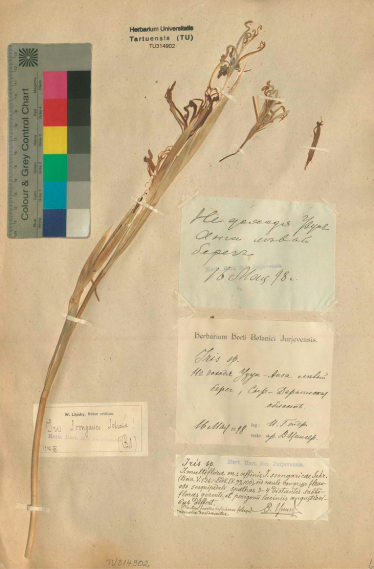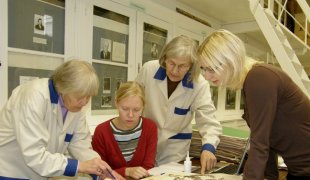Botanical collections

Botanical collections of the NHM UT (acronym TU) is the oldest herbarium in Estonia, started to form with the foundation of the Natural History Cabinet in 1802. Botanical collections include more than 321 000 specimens of vascular plants, bryophytes and macroalgae, including type specimens for 71 taxa in 2021.
The materials have mostly been collected by the scientists of the University of Tartu, supplementing the collections has been a part of botanical research, but collections have grown by donations from private collections and through exchange as well. The oldest dated herbarium sheet in the collection dates back to 1819, the oldest herbarium sheet collected from Estonia is dated to 1834.
The botanical collections (herbarium) of the University of Tartu Natural History Museum hold herbarium specimens of marsh plants, mosses and algae, as well as related materials of scientific and cultural value.
The vast majority of the specimens in the herbarium have been collected by researchers from the University of Tartu during research and expeditions in Estonia and around the world. The collections are also continually expanded through donations and exchanges between herbaria. More than 1000 new herbarium specimens are added to the botanical collections every year. The herbarium specimens stored in the botanical collections are used on a daily basis by Estonian and foreign scientists and amateurs studying the flora, systematics, ecology, distribution and conservation interests of plants and algae from different regions. Materials from the botanical collections are also used in teaching and exhibitions.
Of the 324 001 herbarium specimens, 120 374 have been digitalised. The botanical collections contain 129 type specimens of taxa, of which 24 are holotypes.
Specimens can be searched on the eBiodiversity portal.
In addition, the botanical collections hold collections of fruits, wood specimens and seeds, historical botanical reference literature, scientists' field notebooks, photographs, plant models, and historical botanical study charts and tables.
- The herbarium of vascular plants includes two parts:
- Plantae Estonicae includes of 90 00 specimens collected from nowadays Estonian territory.
- Herbarium Generale holds specimens from all over the world, being largest in whole Estonia and holds more than 200 000 specimens, collected mainly from the area of the former Russian Empire, later Soviet Union.
- The bryophyte herbarium includes around 26 000 specimens, including historical collections and 16 collections of exsiccatae (of an estimated 8 000 specimens), of about 1 600 taxa.
- The algae collections include the herbarium of macroalgae (ca 1000 herbarium sheets), the collection of microalgae (ca 1000 specimens) and the collection of the figures of algae (iconothèque) of an estimated 14 000 sheets with sketches and descriptions of algae taxa.
The botanical collections of the University of Tartu Natural History Museum are open to all researchers, enthusiasts, students and anyone interested in research and education. When working with the collections, please follow the General guidelines for working with botanical and mycological collections to ensure that the materials stored are preserved for future research.
Head of the Botanical Collections Kai Vellak, kai.vellak@ut.ee
Curator of the Botanical Collections Mari Müür, mari.muur@ut.ee
Curator of the Botanical Collections Tiiu Kupper, tiiu.kupper@ut.ee
Curator of the Botanical Collections Kaili Orav, kaili.orav@ut.ee
Curator of the Botanical Collections Tiina Samson, tiina.samson@ut.ee
Curator of the herbarium of vascular plants Ülle Reier, ulle.reier@ut.ee
Database of Estonian plant collections
The database of plant collections comprises data of specimens of vascular plants, bryophytes and algae which are preserved in four herbariums. These are the herbarium of the Botanical and mycological museum in the University of Tartu Natural History Museum (TU), the herbarium of the Department of Botany in the Institute of Agricultural and Environmental Sciences of the Estonian University of Life Sciences (TAA), the herbarium of the Tallinn Botanic Garden (TALL) and the herbarium of the Estonian Museum of Natural History (TAM). The database has been created in cooperation of the University of
See moreInformation about botanical collections in Estonian Research Portal
See moreEstonian Botanical Society of Estonian Naturalists' Society
The Estonian Botanical Society of the Estonian Naturalists´ Society brings together both scientists and amateur botanists to broaden knowledge of plants among its members and in Estonia in general. The Botanical Society organises study days and excursions to learn more about different plant groups and regions, provides guidance on plant identification and observation, and shares botanical travel impressions. Particular attention is paid to the situation of rare plant species in Estonia, their new localities, as well as new species found in Estonia.
See moreThe foundation for the University of Tartu botanical collections was laid by Professor G. A. Germann, who starting from 1803 carried out collection expeditions across Estonia and Livonia, even reaching as far as Finland and the White Sea. In 1806, Germann purchased the first 4000-sheet herbarium for the University, which was displayed in the lecture hall of the principal greenhouse. Starting from the 19th century, the University's botanists have been drawn to expeditions to unexplored Russian territories in Siberia, the Far East, the Caucasus, northern Russia and other sites. From the mid-19th century, botanists also started paying considerable attention to researching Estonian flora.
The collections were supplemented with various seed and specimen collections by Heinrich Moritz Willkomm (1821-1895), then professor of botany and director of the botanical garden. Between 1823 and 1851, several expeditions were made to study the flora of Estonia and Livonia, and on the basis of these expeditions, Alexander von Bunge compiled a 1,000-sheet exiccatalogue of the plants of Estonia, Livonia and Courland (Flora exiccata Liv-, Est-, und Kurlands, Cent. I-X, 1853). His herbarium was later sold to Paris, but the world herbarium of plants contains several duplicates of the herbarium specimens he collected, and it is our collection that has so far yielded specimens missing from other collections.
Herbarium specimens collected for Prof. Nikolai Kuznetsov's review "Flora Caucasica critica" (1901-1916) during his expeditions to the Caucasus (1895-1911) are also deposited in the botanical collections of the University of Tartu.
At the outbreak of the First World War, nearly a quarter of the herbarium was evacuated to Russia, some of which was only recovered in the 1950s through the St Petersburg Botanical Institute. The Botanical Museum of the University of Tartu was founded in 1922 and was headed by Professor Teodor Lippmaa. Prof. Lippmaa initiated the compilation of a collection of exotics of Estonian plants (200 species), of which 4 folders were completed within a couple of decades. The Second World War interrupted all the previous research and the herbaria collections were also severely damaged in a bomb attack in January 1943. Only the first folder of the collection of exotics has survived intact.
As a result of the post-war reorganization, the University of Tartu Botanical Museum (1957) disappeared, and the herbarium was maintained by the assistants of the Department of Plant Zoology. However, during the Soviet period, the herbarium was supplemented with material collected during the research work of the university botanists and the summer internships of students, and several amateur scientists (Albert Üksip, Laura Pihlapuu, Hugo Salasoo, Marie Nelke and others) donated their herbariums to the university.
The most important of the historical personal collections in the moss herbarium are:
Bryotheca Baltica (Johann Mikutowicz, 1901-1908);
Musci Boreali-Americani (William Starling Sullivant and Lesquereux, Charles Leo, 1865);
Die europäischen Torfmoose (Carl Warnstorf, 1892-1896);
Musci frondosi et hepatici exsiccati (Gustav Carl Girgensohn, 1848-1856);
Bryotheca Europaea (Ludwig Rabenhorst, 1858-1873).
The herbarium of algae is small and has been expanded mostly through occasional collections, but in 2006 the Estonian-born Swedish alchologist Kuno Thomasson donated a collection of algae drawings with algal literature. It contains drawings of algae from the 19th century onwards, including original drawings and species descriptions of several algae. Over the years, the iconotheque has been supplemented, mainly in the field of algae, by Erich Kukk, a long-time curator at the Natural History Museum and an algologist. Of historical value is the collection of 133 specimens from Carl Fredrik Otto Nordstedt's excerpt collection of microalgae (1880).




